VC&G Interview: Benj Edwards, Creator of Vintage Computing and Gaming
November 2nd, 2015 by Harry McCracken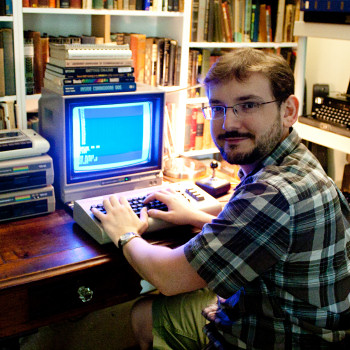 [ Earlier this year, I asked readers what they wanted to see on VC&G’s tenth anniversary. Most people said “behind the scenes coverage,” but I wasn’t sure how to approach that. So I asked my longtime editing partner Harry McCracken to interview me in the hopes that I might accidentally say something interesting about the history of the site. Happy Anniversary, VC&G readers. — Benj ]
[ Earlier this year, I asked readers what they wanted to see on VC&G’s tenth anniversary. Most people said “behind the scenes coverage,” but I wasn’t sure how to approach that. So I asked my longtime editing partner Harry McCracken to interview me in the hopes that I might accidentally say something interesting about the history of the site. Happy Anniversary, VC&G readers. — Benj ]
I first met Benj Edwards back in 2007, when I worked at PC World magazine and he submitted an article — “The 10 Worst PC Keyboards of All Time” — over the transom. (Actually, we didn’t meet in person until later, and his submission arrived in my inbox like any other email, but you get the idea.) Even then, I was already a fan of his Vintage Computing and Gaming website, which was then a couple of years old.
We ended up publishing Benj’s keyboard slideshow at PCWorld.com, where it became a monster hit with readers. Since then, Benj and I have continued our writer-editor relationship: first at Technologizer, and today at Fast Company, where I’m an editor and he’s a frequent contributor, writing deeply-reported pieces about fascinating topics which everyone else has forgotten about. He’s also contributed to The Atlantic, Macworld, PCMag, Wired, and other publications.
Benj has never stopped blogging at Vintage Computing and Gaming, which celebrates its tenth anniversary today. To commemorate the occasion, he asked me to interview him about the site, his other writings, and his pursuit of collectible tech products and the stories behind them. I learned a lot from his answers — and so will you.
–Harry McCracken
10 DAYS OF VINTAGE: Day 1

Collecting Background
Harry McCracken: Let’s start at the beginning. Can you talk a little bit about how you first got interested in old computers and video games?
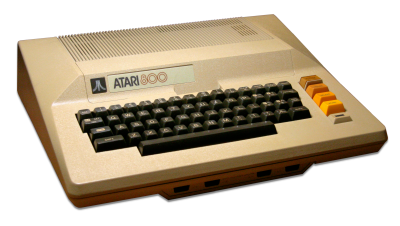 Benj Edwards: Yeah, that goes way back. It really started when my dad bought these old computers when they were new in the late ’70s and early ’80s.
Benj Edwards: Yeah, that goes way back. It really started when my dad bought these old computers when they were new in the late ’70s and early ’80s.
He got an Atari 800 in 1981, which is the year I was born, but he bought it for my brother who is five years older than me. My brother used that as a way to learn to program BASIC, and I spent my early childhood watching him play games on that machine. I didn’t program it myself, but I used it as a game console.
As time went on, as far as video games are concerned, we got a Nintendo Entertainment System in 1988, I think. Up to that point, we’d been playing Atari games, and as Nintendo took over, I wondered why my friends hadn’t played the older Atari games and why nobody talked about them anymore. I loved the old games and didn’t want them to be forgotten. That was my first step into that kind of looking backwards.
Then, as far as collecting video games, I also realized around that time — as the NES turned into the Super NES around ’91 or so — that playing last generation’s games was a lot cheaper because I could buy them used. We didn’t get a whole lot of NES games when they were new because they cost $50-$60 apiece, which in 1980s dollars was over $100 a piece when adjusted for inflation.
HM: Wow.
BE: So I began to focus more on the past in that regard too.
On the computer side of things, when I turned nine or so, my dad wanted me to start learning BASIC, like my brother had done, as an introduction to computers. He started looking for an old computer that ran BASIC around 1989 or ’90, which even then was well into the PC-clone era. He thought an older machine would be easier to use and more appropriate to learn BASIC on.
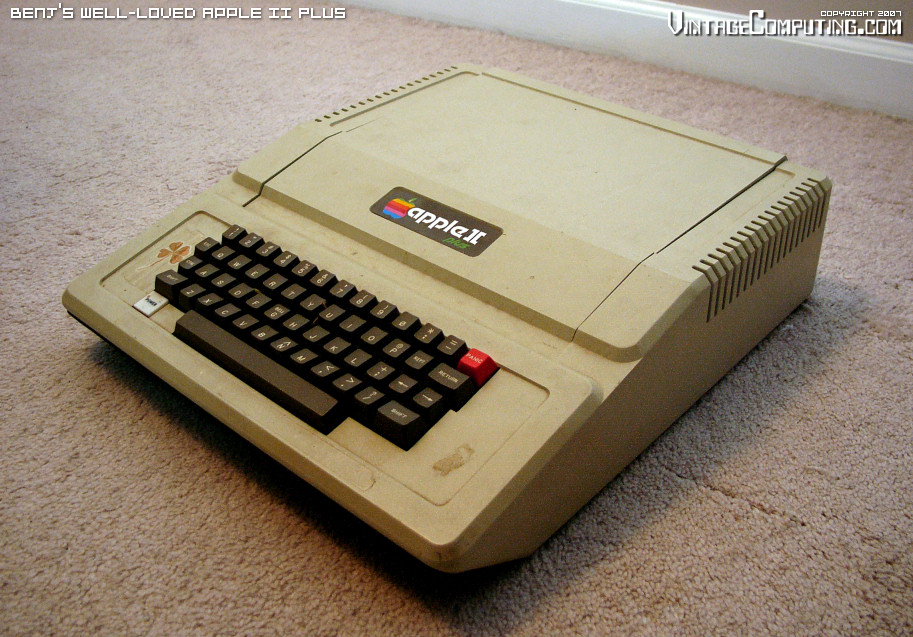 My father and I made it a yearly tradition to attend an event called RARSfest (we called it “the hamfest“) which was local amateur radio gathering every year in Raleigh. We would look at old electronics and things like that, and we went almost every year between the late 1980s and when he died in 2013. My dad found an Apple II Plus there for $100 with a couple disk drives and some games. He bought that for me, and we put it in my bedroom. That was the first computer I ever truly used as something beyond a game machine. That’s how I learned to program BASIC.
My father and I made it a yearly tradition to attend an event called RARSfest (we called it “the hamfest“) which was local amateur radio gathering every year in Raleigh. We would look at old electronics and things like that, and we went almost every year between the late 1980s and when he died in 2013. My dad found an Apple II Plus there for $100 with a couple disk drives and some games. He bought that for me, and we put it in my bedroom. That was the first computer I ever truly used as something beyond a game machine. That’s how I learned to program BASIC.
Of course, if you’re programming BASIC on an Apple II Plus in 1990, you start to wonder why everyone else is not still using an Apple II. They still had them at my school for some time, though — schools held on to their Apple IIes well into the late ’90s for typing classes.
A few years later, I had this running collection of older computers: I’d saved the family Atari 800 and an Atari 400 before that; my Apple II and some older PC-compatible machines. I started thinking, “If everybody’s upgrading their machines all the time, they’re going to throw out the old ones, and nobody will know what happened, what came before. Everybody’s going to regret it.”
I thought I’d start saving and purposely collecting old computers during the PC-everywhere era. I thought that we had lost a lot of variety in terms of all the different machines from the 1980s — you know, different platforms like TRS-80, TI-99/4A, Commodore, and Atari. I thought all that was being lost, so I thought I would save it. That’s pretty much how it started. I was only about 12 years old when that happened — around 1993.
In addition, as a kid, my dad collected old cameras, so I wanted to start a collection that was uniquely mine. I chose computers for the reasons I’ve mentioned.
HM: You’re part of the first generation of people born during the PC era, so it was already history when your interest in old machines started. And yet it was really recent history.
 BE: In retrospect, it’s funny, because when I first started collecting computers in the early-mid 1990s, anything IBM compatible was really boring and repulsive to me in collectible terms. Everyone used them all the time. In the late 1990s, I discarded a lot of IBM machines that I wish I still had because I considered them all generic, cut from the same cloth. I thought each machine wouldn’t necessarily have their own distinctive qualities because they all ran MS-DOS. Now I know that’s definitely not true.
BE: In retrospect, it’s funny, because when I first started collecting computers in the early-mid 1990s, anything IBM compatible was really boring and repulsive to me in collectible terms. Everyone used them all the time. In the late 1990s, I discarded a lot of IBM machines that I wish I still had because I considered them all generic, cut from the same cloth. I thought each machine wouldn’t necessarily have their own distinctive qualities because they all ran MS-DOS. Now I know that’s definitely not true.
HM: I’ve always found that era — sort of the mid-1980s to the early 1990s — to be somewhat boring just because it was the era of the PC clone. It wasn’t so much about innovation as it was about compatibility.
BE: It was that sort of homogeneity in the “beige box” era that inspired me to look to the past and try to preserve its diversity.
HM: I was browsing through your website, and I saw the list of items in your collection. Even as long as I’ve known you, I didn’t realize you had as many systems as you have: dozens of game consoles, computers, and a substantial collection of Apple machines.
Can you talk a little bit about where you find them?
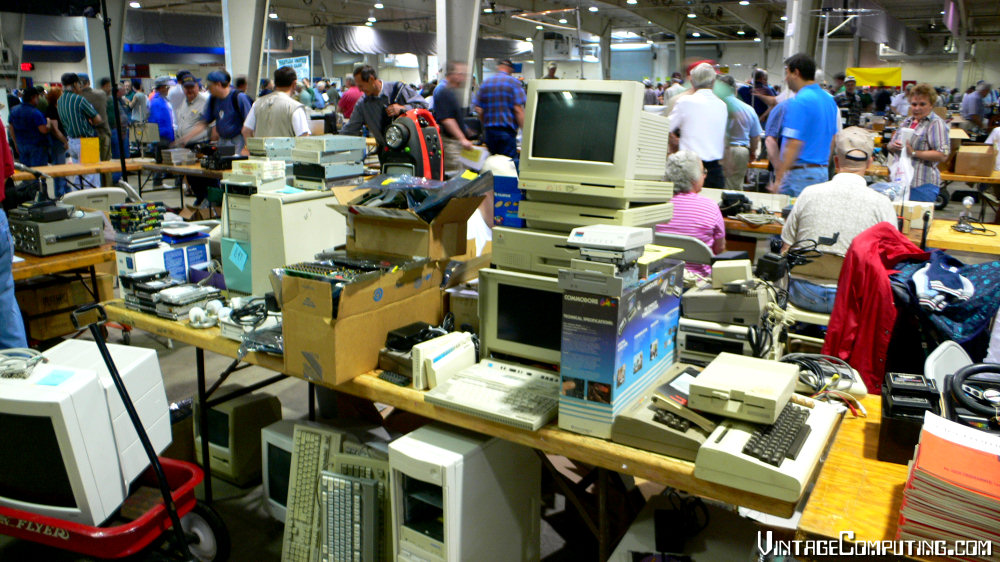 BE: It has changed a lot over the years. At first, I found many computers at the hamfest. They had a swap meet where people would bring their old electronics, and grizzled hacker guys who smoked too much liked to pick through it, feeding an ecosystem of used electronic gadgets that keeps going through the years. That was a great source of machines for some time, and it still is to some extent.
BE: It has changed a lot over the years. At first, I found many computers at the hamfest. They had a swap meet where people would bring their old electronics, and grizzled hacker guys who smoked too much liked to pick through it, feeding an ecosystem of used electronic gadgets that keeps going through the years. That was a great source of machines for some time, and it still is to some extent.
Another important early source came from donations of computers and game systems from family friends and relatives. People would hear that I was a computer collector, so I ended up with the old computers from pretty much everybody I know.
I also found a lot of stuff at local flea markets in the early 1990s, and around 1999-2000, I regularly visited every thrift store in my city and bought every old computer I could find. Then I started buying things on eBay in the late ’90s when I could not find certain things locally.
 For video games, I kept an eye on the clearance aisles of local K-Marts, Wal-Marts, Targets, and Toys ‘R’ Us, where I bought a lot of games and accessories for very cheap in completely new condition. I also frequented used video game stores like Funcoland.
For video games, I kept an eye on the clearance aisles of local K-Marts, Wal-Marts, Targets, and Toys ‘R’ Us, where I bought a lot of games and accessories for very cheap in completely new condition. I also frequented used video game stores like Funcoland.
Some of those sources have since dried up. The local flea market is disappointing now because the old computers I’m interested in are just so old that nobody has them anymore, and if you find a more recent computer at a flea market, they want an obscene amount of money for it. I probably bought all the old computers in the city anyway. [laughs]
Thrift stores also mostly dried up around here in 2001 when they stopped accepting computers as donations, since obsolete machines are mostly worthless for resale. Recently, some non-Goodwill thrift shops have started stocking old video games, though.
HM: You’ve been collecting for a long time. Are there any challenges to maintaining such a large collection?
BE: Plenty of challenges. First of all, it’s hard to know where to put everything. But the main challenge is decay.
It’s funny, but my collecting activities are now creeping into vintage territory. 20 years ago, I would buy an old computer and it would work fine. Fast forward to today, and I tend to assume the same machines will still work because they were working when I got them, and I kept them in good shape. But many of those machines don’t work anymore, because they’re 20 years older now. Things break down chemically over time — especially capacitors, batteries, and rubber belts.
HM: Are there any Holy Grails you’re still looking for after all these years?
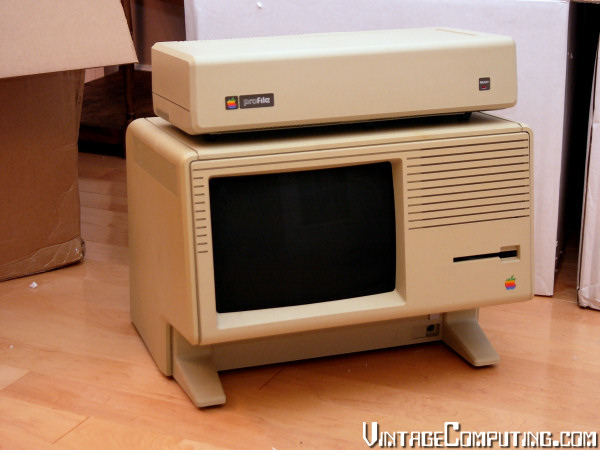 BE: My Holy Grail for a long time was an Apple Lisa. I still don’t have a Lisa 1, which is extremely rare. But I found a Lisa 2 at the Vintage Computer Festival in 2006 for around $200. I shipped it back to my house from California. Ironically, after I wrote about getting that Apple Lisa on my blog, somebody read it and emailed me saying, “Hey, I have one of them too, with all the software for it and everything,” and she just sent it to me for free. It still works — but for how long, who knows.
BE: My Holy Grail for a long time was an Apple Lisa. I still don’t have a Lisa 1, which is extremely rare. But I found a Lisa 2 at the Vintage Computer Festival in 2006 for around $200. I shipped it back to my house from California. Ironically, after I wrote about getting that Apple Lisa on my blog, somebody read it and emailed me saying, “Hey, I have one of them too, with all the software for it and everything,” and she just sent it to me for free. It still works — but for how long, who knows.
HM: Wow.
BE: I still want an Atari Falcon, though. Those are pretty rare. That’s one of my holy grails. They’re kind of expensive on eBay — around $600-$800.
HM: How about software, games, accessories, magazines, manuals, and other items like that?
BE: That stuff actually probably takes up most of the space, because for every system I have there’s a whole constellation of accessories and stuff that goes with it: peripherals, media, manuals, and books.
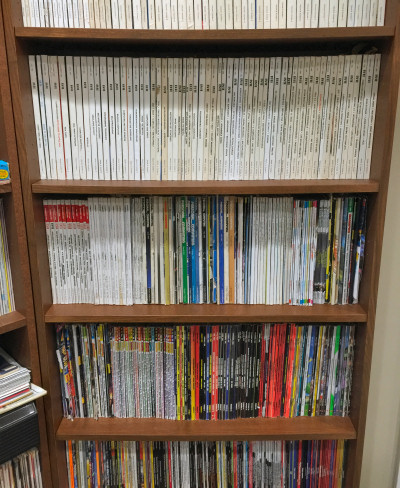 I have many thousands of disks, maybe a one or two thousand game cartridges — I have never counted. CD media? Not as much, probably hundreds or a thousand, depending on what you count.
I have many thousands of disks, maybe a one or two thousand game cartridges — I have never counted. CD media? Not as much, probably hundreds or a thousand, depending on what you count.
As far as magazines go, I first started collecting them when I was a kid because I never threw any of the ones away that I got in the mail.
In 2006, when I started doing Retro Scan of the Week, I made an effort to start buying up big collections of old computer magazines — like Byte Magazine, PC Mag, Compute, Macworld, and Popular Computing.
At the time, some guy was selling large lots of these magazines on eBay. I bought tons of magazines for pretty cheap, and they would show up in these huge 200 lb. boxes that the UPS guy didn’t want to move. He would just give up and set them down at the end of my driveway next to the street.
HM: One of the cool things about being interested in this stuff today is you can get emulators and old software on the web. Does that reduce your desire to actually possess the originals at all, or do you still find it important to have the actual physical items?
BE: For a long time I was stubborn about emulators. Video game emulators weren’t very refined at first, so the original experience with a real console was more accurate for things like the NES and Super NES throughout the ’90s and early 2000s. At that time, I still sought out game cartridges and tried to add to my collection.
These days, most game console emulators for systems released prior to, say, the Nintendo 64 are fairly accurate. They’ve had two decades of refinement. So for the past 8-9 years, I have often relied on emulators for research purposes when writing articles. If I don’t have my original console hooked up nearby, I’ll just start up an emulator. It is an invaluable research tool.
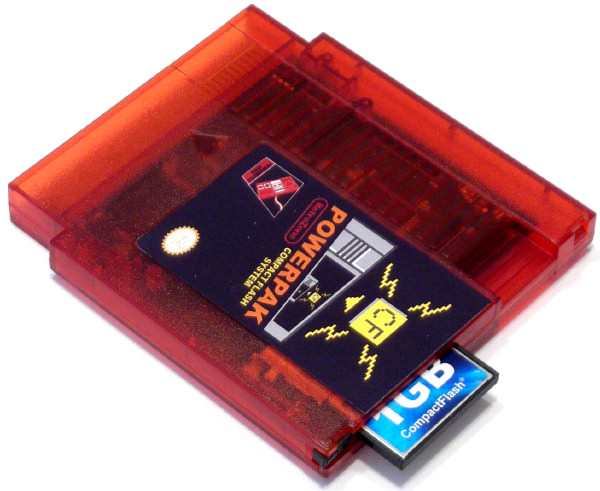 There’s a company called RetroZone, owned by a guy named Brian Parker. He made a flash cartridge for the NES in 2007 that let you put every NES game onto a single cartridge and play them on the original console. After I got one of those, I stopped collecting NES cartridges, because I could play most of them on the original Nintendo. It was convenient because I already had over 200-something NES cartridges, and I had run out of space for more on their shelf.
There’s a company called RetroZone, owned by a guy named Brian Parker. He made a flash cartridge for the NES in 2007 that let you put every NES game onto a single cartridge and play them on the original console. After I got one of those, I stopped collecting NES cartridges, because I could play most of them on the original Nintendo. It was convenient because I already had over 200-something NES cartridges, and I had run out of space for more on their shelf.
As far as computers emulators go, they have also gotten way better. I don’t use them all that often except for maybe some Atari 800, Atari ST, and classic Mac emulators. I did a lot of work for Macworld for a while, and emulators helped, although they still didn’t prevent me from making a mess and dragging out all my Mac machines when I needed them. It usually took three Macs worth of spare parts just to make one of them work. They have become very fragile in their old age.
Emulators have slowed my collecting somewhat, but the authentic experience is still important. For me, the sounds, touch, and even smells of an old machine serve as memory cues that bring back the feelings of what it was like to use the it, so I tend to set up original hardware if possible, even if I could potentially emulate it.

The Birth of Vintage Computing and Gaming
HM: Speaking of articles, let’s talk a little bit about how you went from being a collector to writing about this stuff. I happen to know that fairly early in the history of the web, you started publishing websites. Can you talk a little bit about that?

At the time, I had only a couple of old computer buyer’s guides from the 1980s that had listings in them, so the web started to fill in a lot of those gaps that went beyond my personal experience. I wanted to be a part of that, so I started up a web page that just had some simple links to my favorite “classic gaming” web pages, as they were called at the time, and a couple pictures — whatever I could fit on my few megabytes of web space.
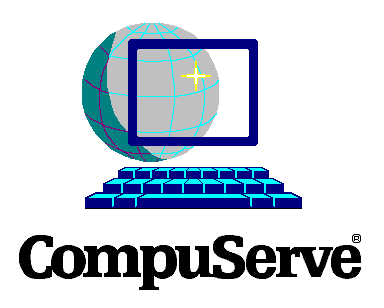 I was active on many CompuServe forms too. That predated my use the web by a few years. There was a “Go Atari” forum where people talked about everything Atari, past and present, and I followed that closely when the Atari Jaguar was released in ’93.
I was active on many CompuServe forms too. That predated my use the web by a few years. There was a “Go Atari” forum where people talked about everything Atari, past and present, and I followed that closely when the Atari Jaguar was released in ’93.
As far as writing goes, a long period of time elapsed between my personal website in the ’90s, which I didn’t update much, and when I started Vintage Computing and Gaming in 2005.
HM: How did Vintage Computing and Gaming get started?
 BE: Well I should probably set the stage with a little background first. I had previously created a website called Request-A-Song.com — I don’t know if you know anything about that. It was a musical project. As a teenager, I got really into writing music and playing keyboards and bass guitar.
BE: Well I should probably set the stage with a little background first. I had previously created a website called Request-A-Song.com — I don’t know if you know anything about that. It was a musical project. As a teenager, I got really into writing music and playing keyboards and bass guitar.
In mid-2000, I had an idea to make a website where visitors to the site would send n suggestions for song titles, and I would write a song based on those titles, then record it and put it online. It wasn’t until 2002 that I actually set up the website and got it running. Publishing original music online was a very new thing then. For about three years, from 2002 to 2005, I did that almost non-stop while sporadically attending college.
Things got off to a fun start, but by 2005, I realized that Request-A-Song wasn’t becoming any more popular, and it definitely wasn’t going to make any money. I got depressed, and I didn’t know what I was going to do next.
 I started reading blogs online when they were still fairly new in 2004 and 2005. I remember that blogs became very famous in the mainstream around the US Presidential election of 2004 because bloggers were suddenly appearing on TV, weighing in, and having a sizable impact on the political discourse in the country. That made blogs mainstream in the US media at that time.
I started reading blogs online when they were still fairly new in 2004 and 2005. I remember that blogs became very famous in the mainstream around the US Presidential election of 2004 because bloggers were suddenly appearing on TV, weighing in, and having a sizable impact on the political discourse in the country. That made blogs mainstream in the US media at that time.
In 2005, I started reading blogs on different topics. Joystiq, Engadget, and Hack-A-Day were three of the first blogs I read. Also, I read Kotaku, started by Nick Denton of the Gawker empire, and a few personal retrogaming blogs that have long since vanished.
On Joystiq, they had a regular post category about retrogaming. They talked about topics like a re-release of an old game, or new hardware for a vintage system. I read that for a while and thought to myself, “Hey, I could do this.”
HM: So what made you take that first step and start a blog?
BE: In that retrogaming section on Joystiq, I read about a new NES clone called the Generation NEX from a company called Messiah that was going to come out in late 2005. It was really exciting, because it was new hardware that promised to run original NES games and Famicom games on the same console, and it would cost around $60. It looked very well-designed on the outside, like a squished down, teeny-tiny NES console, and it had new controllers. I pre-ordered one of those as fast as I could.
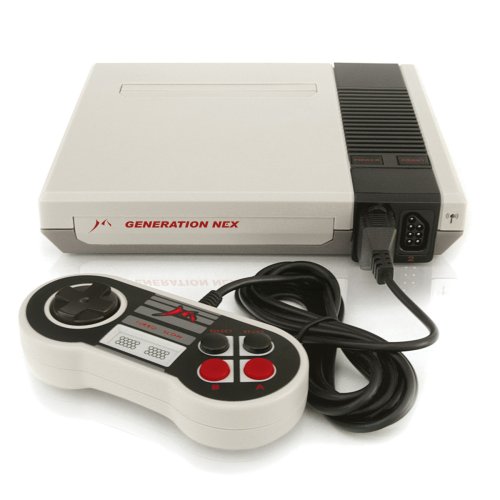 Well, I was one of the first people who got one, and it was just terrible. It was horrible. It was a piece of shit.
Well, I was one of the first people who got one, and it was just terrible. It was horrible. It was a piece of shit.
Meanwhile, the NEX was getting a lot of pre-emptive glowing press, with writers on IGN, Kotaku, and Joystiq talking about how awesome it was, and they had obviously never actually used it.
I was so mad about the console — and the dissonance between the press coverage and reality — that I decided to start my own blog just to write about how horrible it was. That’s when I started Vintage Computing and Gaming, on November 2, 2005.
I actually had registered the domain “vintagecomputing.com” back in 2000, so I had that sitting around. I’d always hoped to start a website that showed off all my computers and games. Before blog software, that kind of thing was a lot of work.
I already had a dedicated server rented for Request-A-Song, so I had a platform available, and I used vintagecomputing.com as a home for my new blog. After writing a couple introductory posts with the goal of looking like I hadn’t completely come out of nowhere, I published my view of the Generation NEX — the very next day, I think — and I panned it horribly. I used terms like “false Messiah” and “Generation SUX.”
I submitted a link to my review as a tip to Kotaku, Joystiq, and several other blogs, and they all ran it. They talked about my review and passed along the word of how the NEX was horrible. Within less than a day, everyone acted like it was common knowledge.
 I thought everyone’s me-too behavior was absolutely crazy at the time, because I had just written that thing and put it up there. My post had a cascading effect within just a day or two. With all those blogs were talking about how horrible it was, they began to cite each other, even though the only real source was my review. The news bounced around and amplified like an echo chamber. It was a startling and dramatic lesson about how news on the Internet worked.
I thought everyone’s me-too behavior was absolutely crazy at the time, because I had just written that thing and put it up there. My post had a cascading effect within just a day or two. With all those blogs were talking about how horrible it was, they began to cite each other, even though the only real source was my review. The news bounced around and amplified like an echo chamber. It was a startling and dramatic lesson about how news on the Internet worked.
My blog got lots of traffic, of course — more traffic in one day than I received in a whole month at Request-A-Song. I was thinking, “Man, I’ve been killing myself with music for years when all I had to do was write one review on a blog.”
Within a few weeks — with nothing but my one review as a source — the Generation NEX was pulled from Lik Sang, a prominent online store that sold it, and within a few months Messiah was floundering. It dropped off the press radar about a year later, then went completely out of business within a few years.
I thought, “Jeez, this is pretty crazy. You can have quite an impact.”
After that, I wrote as many posts as I could manage, and gathered a following with a lot of people commenting. It was an exciting time.
HM: I noticed that your early posts were written under the name “RedWolf.” Can you talk a little bit about what that means?
 BE: When I ran a BBS from ’92-’98, my handle was Red Wolf. I picked it in 1992, because my brother’s handle was Blue Dragon. His favorite color is blue, and my favorite color is red. I’m not positive where I got the wolf part from. But my brother loved dragons, and I thought wolves were cool animals.
BE: When I ran a BBS from ’92-’98, my handle was Red Wolf. I picked it in 1992, because my brother’s handle was Blue Dragon. His favorite color is blue, and my favorite color is red. I’m not positive where I got the wolf part from. But my brother loved dragons, and I thought wolves were cool animals.
Around that time I got a bunch of old comic books from my uncle, and some of them were “Red Wolf” comics by Marvel. I only have a couple issues of them. That may have had some inspiration. Some people ask me if the “Wolfpack” mascot for NC State University, which is here in Raleigh and has red as its school color, had anything to do with it. I never thought of that purposely, although it may have had some subconscious influence.
I went by Red Wolf online on my BBS and then on MUSHes (where I dropped the space in the name) and other online worlds throughout the ’90s. When it came time to start a blog, it seemed a natural extension of my online computer activities, so I went with RedWolf there. I also wanted to have some distance from my previous experiences on the Internet as “Benj Edwards the musician,” which had gotten a fair amount of press on the much smaller Internet at that time, so I could start the blog with a clean slate and no preconceived notions about my identity. For the first year, I went by RedWolf, then switched to Benj Edwards on the blog.
HM: Would you have been surprised back then to learn that you’d still be doing this ten years later? Or were you trying to develop something that might be around for the long haul?
BE: I didn’t expect to do it for ten years. Of course, I didn’t expect to write for a living either.
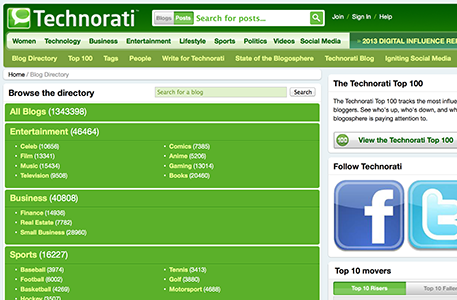 Things change so fast. Personal blogs were very popular the first couple years of doing Vintage Computing — the Technorati era. Most of my traffic came from dozens of other people’s blogs, plus the major ones. And they would link to and comment on my stuff — remember trackbacks and pings? — sometimes copying it wholesale without credit. It’s weird to think about it, but that world is completely gone now.
Things change so fast. Personal blogs were very popular the first couple years of doing Vintage Computing — the Technorati era. Most of my traffic came from dozens of other people’s blogs, plus the major ones. And they would link to and comment on my stuff — remember trackbacks and pings? — sometimes copying it wholesale without credit. It’s weird to think about it, but that world is completely gone now.
I didn’t know how long that would last, what I would be doing in life, or if I’d get tired of it. It’s pretty amazing that I’m still doing it ten years later. I built a nice career on top of it.

Beyond VC&G
HM: Can you talk a little bit about how that other career — freelance journalism — came to be?
BE: I had tried to build Request-A-Song.com into a a business by selling CDs, merchandise, and songs à la carte for 88 cents a piece — not long after the iTunes Music Store started — that was a big deal back then. I didn’t make any money, and my college interest was waning, and I was thinking, “What am I going to do as a career?”
 Earlier, I had just barely studied political science in college, and I didn’t complete my degree. I wasn’t particularly interested in political science that much — it was more like a hobby. When I took two elective astronomy classes in one semester, my department counselor called me and said, “What the heck is going on?”
Earlier, I had just barely studied political science in college, and I didn’t complete my degree. I wasn’t particularly interested in political science that much — it was more like a hobby. When I took two elective astronomy classes in one semester, my department counselor called me and said, “What the heck is going on?”
Once the blog started taking off, I thought, “Maybe I could do this for a living,” and I began to look into freelance writing.
In 2006, when I was looking for old magazines and source material, I found a guy named Tom Halfhill who used to work as a senior editor at Byte Magazine, and I emailed him. I think I emailed you at PC World around the same time. I was hoping that computer publications had these huge archives of old product press photos that I could draw material from, but it turned out not to be the case.
 The Vintage Computer Festival was coming up that year in October at the Computer History Museum in Mountain View. Tom invited me to come to the museum, where he volunteered, and meet up there. Through email and meeting him in person, he gave me some tips about freelancing: how to do it, how to handle contracts, what rates he made freelancing. He was a very important early mentor. After that, I threw my energies into writing bigger and longer features on my blog to serve as a living resume for my intended career.
The Vintage Computer Festival was coming up that year in October at the Computer History Museum in Mountain View. Tom invited me to come to the museum, where he volunteered, and meet up there. Through email and meeting him in person, he gave me some tips about freelancing: how to do it, how to handle contracts, what rates he made freelancing. He was a very important early mentor. After that, I threw my energies into writing bigger and longer features on my blog to serve as a living resume for my intended career.
My first taste of non-VC&G work came in a column I wrote about old game advertisements on GameSetWatch, which was a video game blog, in late 2006. Then in early 2007, I did a feature for my blog about why Super Nintendos turn yellow. I treated it like a feature article and did significant research, which was unusual for blogs at the time. I talked to a professor of plastics and found out that the plastic degrades, and it discolors. It was a big hit and got tons of traffic.
At that time, 1UP.com was looking for freelancers, so I applied to be a freelancer there. They accepted me, and I started writing for them. I also did interviews with Ralph Baer and Steve Wozniak, whom I had come in contact with through my blog, for Game Developer Magazine around that time.
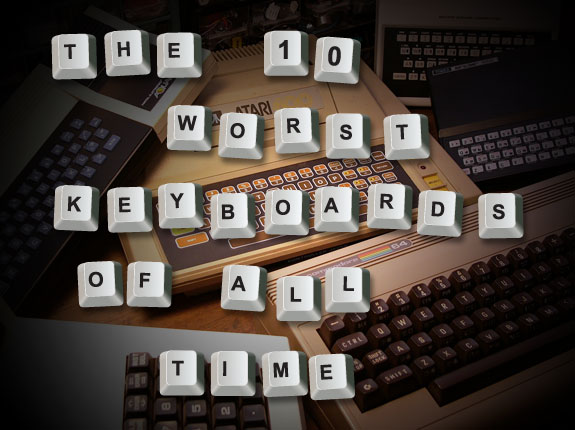 Then I pitched to you in late 2007 about the “Ten Worst PC Keyboards of All Time.” I had read Dan Tynan’s PC World articles about “the worst tech and this and that.” I loved those pieces, so I thought about how to apply that obviously successful template to my field.
Then I pitched to you in late 2007 about the “Ten Worst PC Keyboards of All Time.” I had read Dan Tynan’s PC World articles about “the worst tech and this and that.” I loved those pieces, so I thought about how to apply that obviously successful template to my field.
I picked “worst keyboards” as a topic because I wanted to complain about it somewhere. I was always so frustrated by those crappy old keyboards that came on early home PCs. I wrote it on speculation and sent it to you.
If you’ll remember, my keyboard piece originally wasn’t a slideshow, but you turned it into one, and that became one of my specialties. I’ve probably made 150 slideshows since then.
After you gave me that assignment on PC World, I got an assignment on Macworld, then I got an assignment on Wired, and so on. That got me rolling, and I stopped updating my blog as much. I kept doing Retro Scan of the Week so it wouldn’t be totally empty.
HM: Regarding that keyboard article, I remember sitting around the office with a colleague who told me confidently that there was no way anybody would care about crummy old PC keyboards, and I thought there was a chance that people might care. It turned out to be one of the most popular stories we ever ran.
Ever since then, I continue to be impressed by your ability to come up with ideas which nobody has ever done in history of journalism, which turned out to be insanely popular. Is that just something you have a knack for, or do you have a method of generating ideas for articles?
BE: You’re probably being too generous, but I appreciate it. I try to think big and avoid competition. My dad was like that, and he started his own company that he later sold.
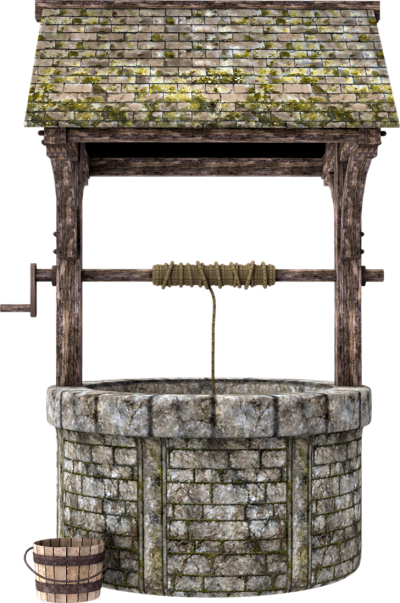 I found a niche in video game and computer history, and it was an easy niche to fill because there wasn’t any competition when I started. In the early days, I used to hop from publication to publication asking them to consider taking a shot at covering the past. Some of them still think I’m crazy, but when it worked, it worked well.
I found a niche in video game and computer history, and it was an easy niche to fill because there wasn’t any competition when I started. In the early days, I used to hop from publication to publication asking them to consider taking a shot at covering the past. Some of them still think I’m crazy, but when it worked, it worked well.
Overall, I try to stay away from what everyone else is doing. Attention is a limited resource that can be used up. If everyone pulls water from the same well, it dries up. I drill my own wells if possible.
HM: With your stories, a lot of time they turn out to be regarded as news, even if you’re writing about something that’s thirty or forty years old. As your editor, I know that other people react to your stories and praise them. They talk about them on Twitter the way they do about a news article.
BE: I appreciate you saying that about me. The key is that tech journalism has always had a fetish for the future. It’s always been what’s new and what’s fresh. Suddenly, looking backward becomes a really exciting, different thing.
I found an untapped need that comes from everyone’s experiences in life. It comes from their upbringing, nostalgia, and their personal experiences with technology; those formative experiences became integrated into their culture and their personal history as they grew up. They became part of how they personally identify themselves, similar to how people root for sports teams. Technology was a big part of their lives. When you touch that, you’re touching the core of a person in a way that’s very personal and powerful. I think that’s probably why my history stuff has been more successful than people expect, because it really touches the core of a person’s being. Does that make sense?
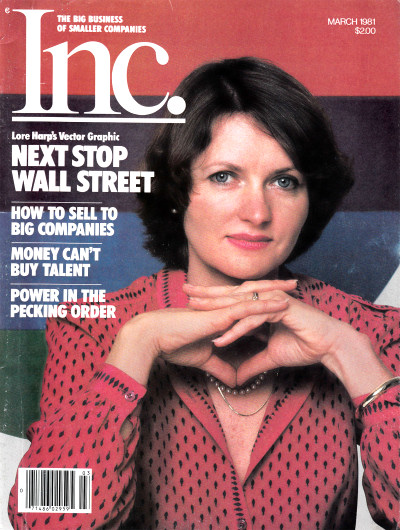 HM: Absolutely. I’m also impressed by the fact that, if somebody who you should interview is still alive, you will find them and interview them — even if nobody has ever interviewed them, or nobody has talked to them in a long time — such as you did with Lore McGovern. You were probably the first person to talk to her about her computer career since the ’80s.
HM: Absolutely. I’m also impressed by the fact that, if somebody who you should interview is still alive, you will find them and interview them — even if nobody has ever interviewed them, or nobody has talked to them in a long time — such as you did with Lore McGovern. You were probably the first person to talk to her about her computer career since the ’80s.
Can you talk a little bit about how you find these people and your experiences in talking to them about their work?
BE: It’s been really fun finding people like that. I usually try to work through people who might know how to contact them first, but many times with more obscure topics, it comes down to taking a guess from a listing in a phone book and giving them a cold call out of nowhere.
I think I realized I could do that when I was doing my Lunar Lander piece for Technologizer. I had no known sources for where Lunar Lander the game came from on the Internet or in books. That info didn’t exist in writing, so I had to actually find the people who made the various versions of the game and talk to them to get the information.
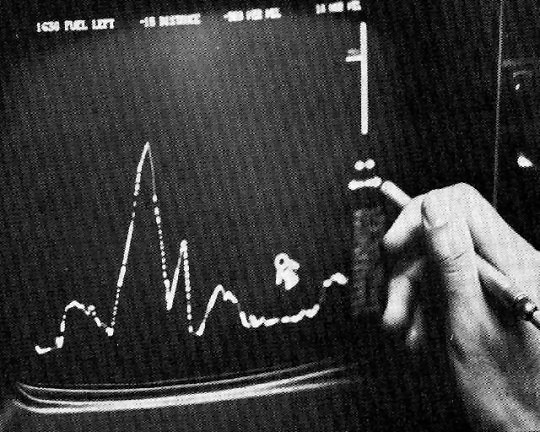 As someone who wasn’t trained to be a journalist, that was a breakthrough for me, because a lot of writers these days — who are perpetually short on time and budget — conduct research quickly using already existing online media about a subject, or rarely, printed media. For that piece, I had to reach out into the world of never-before-published material.
As someone who wasn’t trained to be a journalist, that was a breakthrough for me, because a lot of writers these days — who are perpetually short on time and budget — conduct research quickly using already existing online media about a subject, or rarely, printed media. For that piece, I had to reach out into the world of never-before-published material.
I had done interviews before with people like Ralph Baer and Steve Moore that were just set up to be stand-alone interviews, not necessarily for a certain story. This was opening up a whole new world of research for me: talking to people that no one else really knew about.
I find that these people who aren’t quite as famous are often very eager to talk to somebody about what they’ve done, because they put a big chunk of their life into their work and they thought nobody was ever going to appreciate it again. They’re typically pretty happy to talk to me about it as long as I show respect and appreciation for what they’ve done, and I try to make sure they know that I’m not working in an exploitative way. I want to actually honor their work and their history. That helps a lot.
HM: Speaking of Ralph Baer, the great thing about doing what you’re doing is that an awful lot of these people are still alive, but some of them are no longer with us. You’re preserving some of this history that might disappear if people like you weren’t doing what you do.
BE: Yes, that’s a very important part of it.
HM: You mentioned Lunar Lander, which is one of the stories which goes back quite a few years before you were born. You’ve also done some great stuff from the 1970s. Are you equally interested in the industry where the connection isn’t quite as personal as Nintendo and Atari and some of the products that you grew up with?
BE: Yeah, it’s been interesting branching out beyond that window of my birth to teenage years — that formative period of influence with technology. I have tried to reach back and do things that are older, like the Fairchild/Alpex story. The Ralph Baer stuff was in the ’60s.
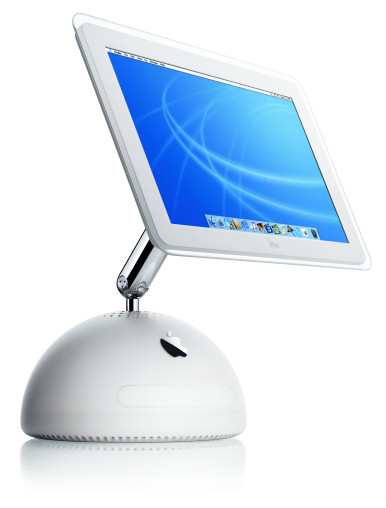 I just have to find some kind of hook that makes people interested in it, as far as older is concerned. As for newer things, I’m still interested in technology, and it’s still part of my life, so as long as I keep using contemporary machines and products, it’ll eventually become part of my history that I’ll write about again when it gets old.
I just have to find some kind of hook that makes people interested in it, as far as older is concerned. As for newer things, I’m still interested in technology, and it’s still part of my life, so as long as I keep using contemporary machines and products, it’ll eventually become part of my history that I’ll write about again when it gets old.
I bought an iMac G4 in 2002 when it came out, and it was just the newest, coolest, most cutting-edge thing. Who thought it would ever be old? Ten years later, I wrote about it for Macworld. I think it can go on forever, honestly. There’s always new history being made every day.
HM: You often talk about topics that are nearest and dearest to your heart. I feel like whenever we talk about Nintendo, you seem to be particularly excited. Is that one of the things you care about most? Are there other ones?
BE: Yeah. Nintendo was a big part of my childhood, obviously, because I grew up during the height of the NES.
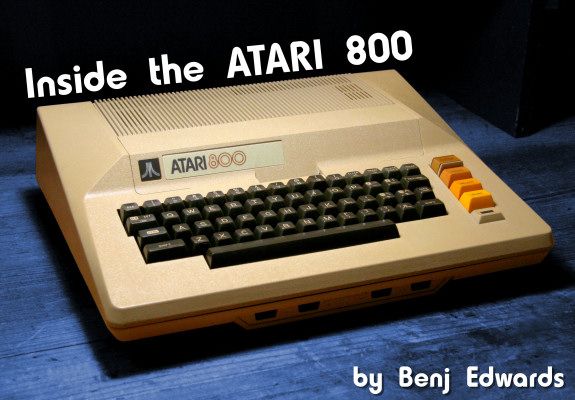 Also, the Atari 800 is probably my favorite subject, because it’s still my favorite platform. There are thousands of amazing games that were made by indie developers on that computer that most people don’t know about, and they’re still fun to play. It really takes me back to a happy time in my life when I was a kid playing those games.
Also, the Atari 800 is probably my favorite subject, because it’s still my favorite platform. There are thousands of amazing games that were made by indie developers on that computer that most people don’t know about, and they’re still fun to play. It really takes me back to a happy time in my life when I was a kid playing those games.
Anything Apple is really fun. I’m not a partisan computer user. I’ve never been all Mac or all PC or anything. I’ve used DOS or Windows PCs since the early 1990s as my main work computers, but since 2002 I’ve used a Mac almost equally for other things like web browsing, instant messaging, music management, or media creation and photo managing. I’m a Mac and a PC.

Vintage Computing and Gaming Traditions
HM: Getting back to your blog, I would be remiss if I did not ask you about your longtime correspondent Ulaf Silchov. Could you talk a little bit about him?
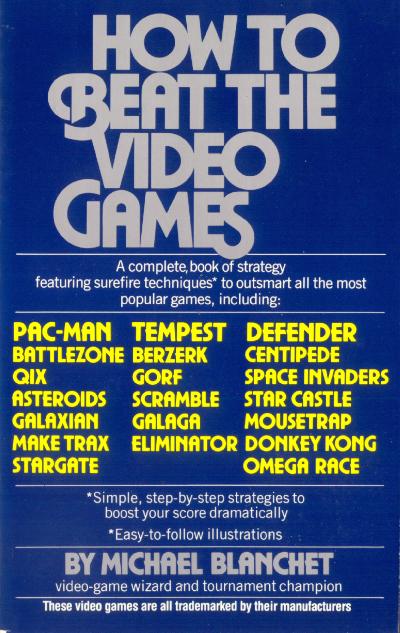 BE: Ulaf started as a joke based on one particular book that I found. I probably bought it at a thrift store. It’s called, “How to Beat the Video Games,” and it has that distinctive, seemingly extraneous article in the title describing video games. That construction is very unusual in modern terms, because we just say “video games” as a blanket term for the whole art. But in the early ’80s, people talked about each video game as a separate thing, because they were originally separate arcade machines. This book followed that convention by saying “the video games,” with an emphasis on “games,” as in, “here’s all the games that are video,” versus, say, pinball games.
BE: Ulaf started as a joke based on one particular book that I found. I probably bought it at a thrift store. It’s called, “How to Beat the Video Games,” and it has that distinctive, seemingly extraneous article in the title describing video games. That construction is very unusual in modern terms, because we just say “video games” as a blanket term for the whole art. But in the early ’80s, people talked about each video game as a separate thing, because they were originally separate arcade machines. This book followed that convention by saying “the video games,” with an emphasis on “games,” as in, “here’s all the games that are video,” versus, say, pinball games.
Then I found two other books: “How to Master the Video Games,” and “Buying and Beating and the Home Video Games.” I had three of those books. I thought, “Man, these titles sound like what a non-native English speaker would say.” I imagined an eastern European guy saying, “I like to beat the video games.” The Borat movie probably had something to do with it, and I had a song on Request-A-Song called “I Don’t Speak English,” where the joke is that a foreign guy named Olaf Hendrikson sings the words “I Don’t Speak English” (in a voice similar to how I imagine Ulaf talking) over and over again, not realizing exactly what they mean.
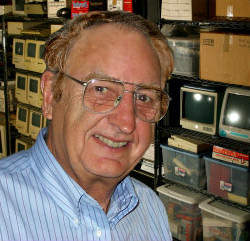 I thought I’d tie those three “the video games” books together into a humor piece with a fictional author that didn’t speak English very well, but he treated the titles seriously as if that was how you always referred to them — also, he talks as if you put “the” in front of just about everything, including video games. That became Ulaf, and over the years he’s popped up now and then to varying degrees of reception.
I thought I’d tie those three “the video games” books together into a humor piece with a fictional author that didn’t speak English very well, but he treated the titles seriously as if that was how you always referred to them — also, he talks as if you put “the” in front of just about everything, including video games. That became Ulaf, and over the years he’s popped up now and then to varying degrees of reception.
I have a couple of hardcore readers that love everything Ulaf, so I still bring him out every once and a while as an inside joke. Then there are other people that are always confused. I remember that, at first, some non-native English speaker readers found him very offensive. Ulaf has been a good lesson in the worldwide nature of the Internet and how you can’t appeal to all audiences at the same time. You have to have a certain cultural focus to get Ulaf.
I don’t want to make fun of anybody or say that eastern European people are stupid — in fact, Ulaf is really a genius, he just doesn’t speak English very well. It’s always been a tough line to walk to try to make it funny. He always writes in all caps, and tries to avoid to-be verbs and the singular first-person nominative, and some other literary tics. I have a rough style guide for him.
HM: Where did you get that photo of Ulaf from?
BE: It’s a 1998 photo of a longtime, close family friend named Otto that I digitally disfigured on the computer, and I placed it on a different background. That photo means something different to me now because Otto passed away a couple years ago, and I think of that when I see Ulaf. But interestingly, I inherited Otto’s old computers, including a rare SWTPC 6800 from 1975 that he built from a kit. It was possibly the first personal computer used at Duke University.
HM: Tell me about your longest running column, Retro Scan of the Week. Do you ever run out of material for that, or imagine that it might happen?
BE: The fountain of scans is fairly infinite with all the magazines and materials I have. I can probably keep scanning them for the rest of my life. I’m just doing one at a time, one week at a time. I used to worry that I would run out of material a long time ago, which was probably before I bought all those magazines.
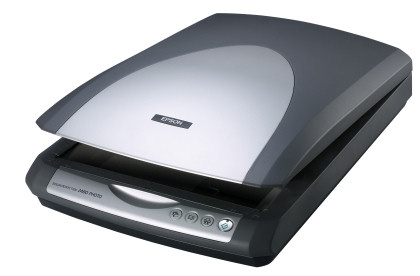 At times I have been afraid that, as scanning became more prevalent online, there wouldn’t be a need or a place for my column anymore. When I started doing it in 2006, there weren’t very many scans of old magazines online, or old ads. It was a genuinely novel source of old material online, pretty new for the Internet.
At times I have been afraid that, as scanning became more prevalent online, there wouldn’t be a need or a place for my column anymore. When I started doing it in 2006, there weren’t very many scans of old magazines online, or old ads. It was a genuinely novel source of old material online, pretty new for the Internet.
For the past five to eight years, there’s been a big effort to digitize and scan every page of every magazine and upload them. It happened first in certain forums, and now, thanks to Jason Scott, they’re all on the Internet Archive. And Google started scanning magazines, as you know. We have both used that as a resource for our articles. It’s very useful.
I find that Retro Scan has remained relevant because it has served as an excuse to talk about my personal experiences with these particular things that I’ve scanned. If I just threw the scans out there and didn’t talk about them, that would be pretty bland, because some of the scans I do are technically already out there now.
Also the comments are priceless, because other people comment on them and share their stories. I like that about my blog. It serves as a sort of personal history archive where all these people come in and write about their own experiences on there. I hope it’s useful to future historians for contemporary accounts of these things.
HM: Are there regular readers of Vintage Computing that have been active since the start?
BE: There are a handful I know of personally. I’m not sure how many there are exactly, but there’s always more people reading than I realize.
In 2013, the comments on my posts just sort of died off. Nobody was commenting anymore. The traffic stats were higher than ever, but that can be deceiving, as you know.
 I didn’t know what happened, so I asked on my blog, “Where is everybody? Where have all the comments gone? Should I still keep doing this?” I received around fifty comments on that post in a few days, so I thought, “Wow, I guess people do still read it.” That was an eye-opening experience.
I didn’t know what happened, so I asked on my blog, “Where is everybody? Where have all the comments gone? Should I still keep doing this?” I received around fifty comments on that post in a few days, so I thought, “Wow, I guess people do still read it.” That was an eye-opening experience.
As it turns out, the way people consumed blogs had changed. In the two previous years before that, Twitter took hold very strongly, Facebook’s personal timeline view started, and people began getting news from those sources instead of RSS readers. My site runs on old blog software that just has RSS. I have a Twitter account for the site but never really did anything with it.
When I read blogs for years, I just went directly to the URL in a browser and looked at it, and I don’t think people do that any more. Of course, I don’t really either.
HM: Are all the Retro Scans really your scans rather than things you found on the Internet?
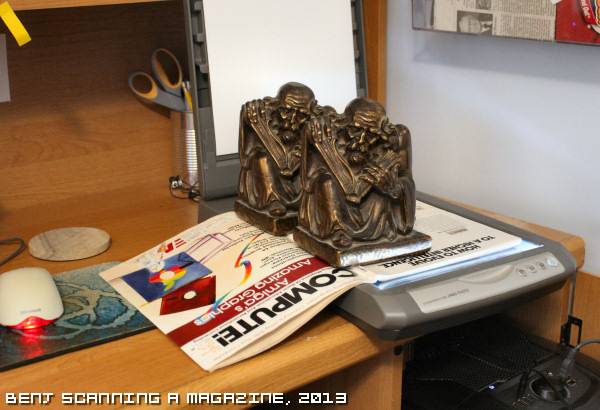 BE: Yeah, every single one is something I personally scanned. I’ve always made a point of that. Years ago, people tried to email me their own scans, but I have never used them. I just thought it would be somehow more authentic to control the whole process, because I like to have a high quality scan. For many years, I spent an obscenely long time retouching scratches, dust, and damage out of each one to make them look really presentable and pristine looking. I like pure digital white and digital black backgrounds.
BE: Yeah, every single one is something I personally scanned. I’ve always made a point of that. Years ago, people tried to email me their own scans, but I have never used them. I just thought it would be somehow more authentic to control the whole process, because I like to have a high quality scan. For many years, I spent an obscenely long time retouching scratches, dust, and damage out of each one to make them look really presentable and pristine looking. I like pure digital white and digital black backgrounds.
I don’t know how authentic that is from an archivist standpoint, but it has made the scans more accessible and attractive to modern audiences, and I have always saved my unretouched original scans. One day I plan to dump the whole thing into the Internet Archive. It’ll happen sometime. I don’t know when — maybe whenever I stop doing it.
Retro Scan of the Week is going to be ten years old in March 2016, so I will have been putting up a new scan every Monday for ten years. Oh, man.

Legacy
HM: Not to end on a morbid note, but do you ever think about the fact you have this important collection and that people might care about it even if you’re not around anymore? Do you think about what you might do with it in the long term?
BE: Yeah, I’ve thought about it over the past five to ten years or so, because my collection got really big. It started taking up a lot of space.
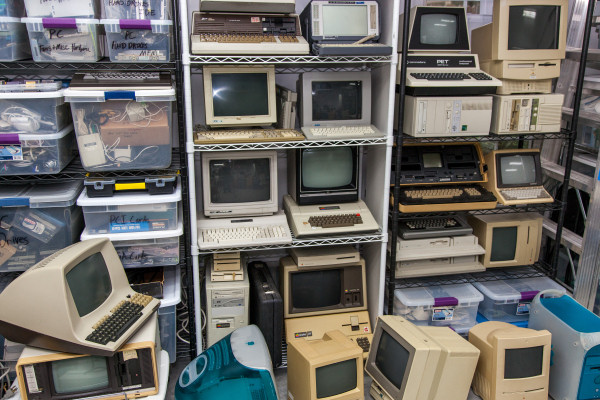 I had a very deep one car garage at my old house that was filled pretty much floor to ceiling with stuff, and you could walk maybe in the middle. I think it was an eleven foot ceiling. That’s the crazy part, because you walked down from the house a couple feet, and then the ceiling was very high off the floor.
I had a very deep one car garage at my old house that was filled pretty much floor to ceiling with stuff, and you could walk maybe in the middle. I think it was an eleven foot ceiling. That’s the crazy part, because you walked down from the house a couple feet, and then the ceiling was very high off the floor.
There’s just so much stuff, and I was thinking, “I’m married and I have kids now. What’s going to happen if I die? What is my wife going to do with all this stuff? Is she going to throw it away?”
I’ve thought about various museums. I’ve made inquiries with certain collections to see if they’d be interested in my magazines and my hardware. I never made any firm plans, because a lot of my stuff got moldy one summer when I didn’t have a dehumidifier in the garage, and so everything is not pristine collector quality. I do have some things that are very well preserved, but the majority of it I just bought to use and play with myself for cheap, and it wasn’t fancy. Sometimes it was stuff that was broken and I had to fix, and I don’t know how desirable that is for a university collection when they could possibly access other versions that are in better shape.
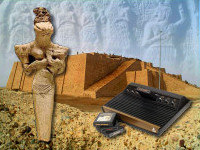 I’m pretty sure the Computer History Museum has everything I have in better quality, for example. The Strong’s video game museum, my personal favorite, probably has every video game I have sealed in its original box.
I’m pretty sure the Computer History Museum has everything I have in better quality, for example. The Strong’s video game museum, my personal favorite, probably has every video game I have sealed in its original box.
I don’t know if any institution nearby would be interested in this stuff yet. I think the time has not quite come for that yet. I attended NC State, and maybe they will have a computer collection someday. I’ve made a few inquiries to various programs there, but they never responded.
If I keep my collection for another twenty years, I think at some point a local organization is going to look back and say, “Hey, this is important heritage. Maybe we should acquire some of this stuff for our own research.” Hopefully, I’ll be able to fill that need at that time. I don’t know what the long term legacy of it is.
HM: I’m quite confident they’re going to care in a hundred years from now, two hundred years from now and beyond.
BE: I think my best contribution to history will not be my collection of physical items, but my interviews and stories.
When I began writing those history stories years ago, and talking to people that absolutely nobody knew about, I woke up in the middle of the night in a cold sweat thinking, “Oh my God, if I hadn’t talked to these people no one would ever know these things. They would die and they’d take these stories to their grave.” I suddenly felt responsible for archiving a lot of stuff, and it got very overwhelming. I can’t do everything.
So my biggest contribution is not the physical stuff. It’s the stories. That’s what I can give that is unique.
HM: That’s a great note on which to end. Congratulations again on the anniversary, and I’m looking forward to seeing what you do over the next ten years of your blog and through your work as a historian.
BE: Thanks. I appreciate your help and the role you’ve played in my career. You’ve been a great friend and mentor, and I really appreciate that. And a great patron of history, too.
HM: It’s an honor, Benj.
Harry McCracken is the technology editor for Fast Company and the creator of Technologizer. He previously served as an editor at large for Time Magazine and Editor-In-Chief of PC World.



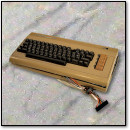
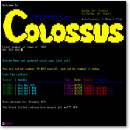

November 2nd, 2015 at 9:48 am
A fantastic interview from the other side. Thanks for the years of dedication to your vocation!
November 2nd, 2015 at 2:55 pm
This seems like an appropriate time to thank you for this site and your writing. The depth of the content here is amazing, it’s easy to see that this is a labor of love for you. To many more years!
November 2nd, 2015 at 6:10 pm
Great interview! And thanks for continuing to maintain the site. I look forward to it every week
November 3rd, 2015 at 9:59 am
Thanks, guys — and thanks for reading VC&G.
Remember, comments are like the air that I breathe. This site will suffocate without them. So I appreciate you taking the time to comment.
November 3rd, 2015 at 10:41 pm
Congrats Benj! I’ve enjoyed your blog for many years now – not sure when I first found it. I think my earliest memory of it is laughing like crazy while reading your write-up on the Colecovision Super Action Controller.
So by your site’s guiding 10-year definition of vintage, you can start reporting on your own blog posts as vintage internet memorabilia now, right?
November 4th, 2015 at 10:15 am
Indeed, Zoyous. Although I think I’ve revised my vintage definition to 15+ years over time by popular demand. As the console life-cycles have grown longer, it’s been necessary to stretch it out a bit. Otherwise I’d be talking about the Xbox 360 on here, which doesn’t feel right yet. Of course, I’ll still talk about 10-year old stuff if it is obsolete and/or feels appropriate.
And look — I’m already peering backward at this site’s history. Did you see this week’s Retro Scan? 🙂
November 5th, 2015 at 8:40 pm
Indeed. Thanks for all the work you’ve put into this Benj. As you pointed out, the interviews are possibly the true treasure; but of course the entire blog is a gem. Even if/when you reach the point where it’s time to stop, VC&G will still be a great resource for a long time forward.